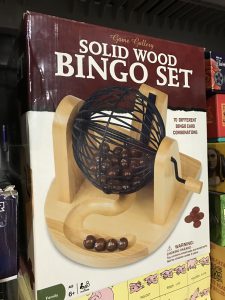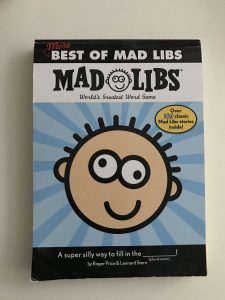Ready to learn about the Word Gap?
I love to sneak learning into all parts of life. I’m a curious person, I can’t help it! My son asked if we could go on one vacation without learning things, and I answered with a maniacal laugh and a deep, sonorous NO. In this family, we love to learn!! And we talk about what we learn!!
Seriously, learning does not have to be boring. Learning can be fun if you do it the right way. And the right way is to make it into a game.
On car trips, when our kids were very little, we played rhyming games. They are all now school age so we will often play ‘Spelling Bee’ and give our kids funny words to spell at their grade level. We also keep a small but mighty trivia book tucked in a seat pocket and take turns passing it around and answering questions.
But let’s say you’re not on vacation and want some fun learning games for young kids. My first recommendation is BINGO. Yes, the classic game of Bingo is perfect to start playing with young kids (and older kids).

Learning Numbers
When my oldest started kindergarten, I couldn’t wait to volunteer and help out. So as we neared Halloween, his wonderfully patient and experienced teacher invited me in to play a game with the class. I brought in our Bingo game set, complete with rolling ball and playing cards and red plastic markers. I started calling out letters and numbers and my son (and maybe a few other students) marked their cards. But most of the kids didn’t know what I meant when I called out double-digit numbers.
I felt embarrassed, but I also knew these kids could learn these numbers and that a game like Bingo was the perfect way to help them. We had been playing Bingo with our kids for a long time. If I hadn’t been so flustered, I could have written the numbers on the board and helping the kids look at their cards and match them up. I also could have done peer teaching and paired kids up.
Learning Words
It’s really important that kids learn their numbers, but it’s also important that they master our language and learn the parts of speech. Having a strong and varied vocabulary increases our ability to explain ourselves and understand others, to express complex thoughts and build connections between concepts and create new ideas. And that’s where Mad Libs comes in.

Yes, Mad Libs. That old school paper book (not an e-device) that asks players to write in verbs, adjectives and nouns. The one where you couldn’t resist writing “butt” and “poop” at least a few times. It works.
My friend took a Mad Libs story into her son’s fourth grade class as a part of a holiday party and she was surprised how few kids could provide suggestions for the parts of speech. Standards in third grade already covered adjectives, adverbs and proper nouns! By fourth grade, students should be able to provide appropriate suggestions for those parts of speech. But even if they struggle, Mad Libs is a fun, non-academic way to encourage them to think about what kind of word is both grammatically logical but also hilariously out of place.
The Word Gap
Thinking about Mad Libs brings me back to the Word Gap. Simply put, kids from low income families are hearing and learning fewer words than kids from high income families. By age 3, kids from low income families are hearing 30 million fewer words. 30 million. And the discrepancy only increases as the kids age. It impacts these kids in terms of school success, which in turn impacts their chances of continuing education, job readiness, and the cycle of poverty.
A lack of words? It’s totally unfair.
It seems so bitterly unjust to me, someone who loves to talk and learn, that these children are already behind due to a lack of words. I try never to talk ‘down’ to children (or adults). But lots of people aren’t aware of this and say they aren’t sure what to say to kids. And sometimes when I take my children’s writing to more general critique groups, I get comments that my vocabulary is too high and I need to ‘dumb it down’ or ‘make it more kid friendly.’
But now you and I know being kid friendly means offering them more words, not less.
There are some amazing ideas out there. People are working to increase the number of words kids see, hear, read, learn and say. I’d love to contribute in some way to reduce the Word Gap. I’m going to keep thinking about it and I’m going to ask my kids what they think would work.
How would you reduce the Word Gap?
